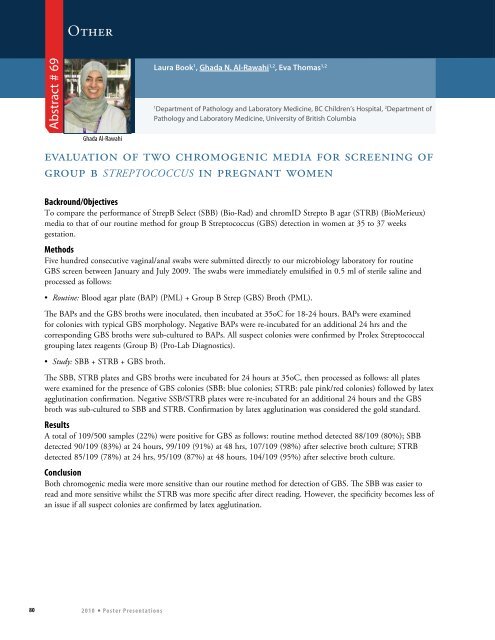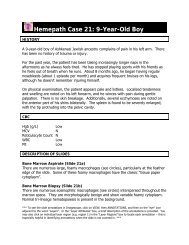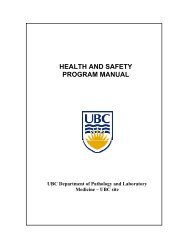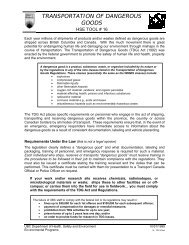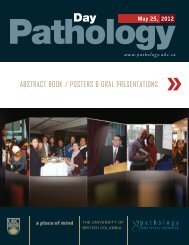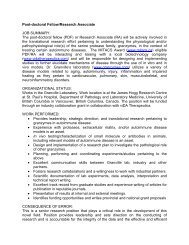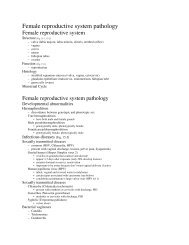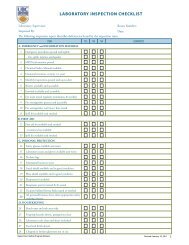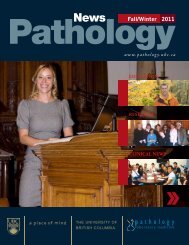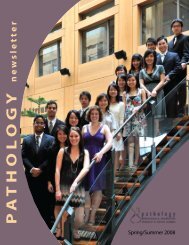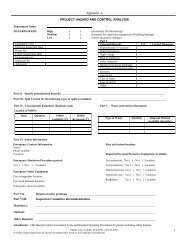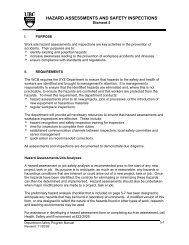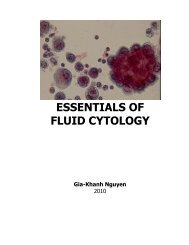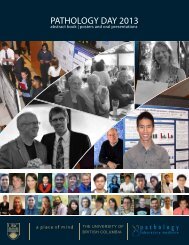OtherAbstract # 69Laura Book 1 , Ghada N. Al-Rawahi 1,2 , Eva Thomas 1,21Department of <strong>Pathology</strong> <strong>and</strong> <strong>Laboratory</strong> <strong>Medicine</strong>, BC Children’s Hospital, 2 Department of<strong>Pathology</strong> <strong>and</strong> <strong>Laboratory</strong> <strong>Medicine</strong>, <strong>University</strong> of British ColumbiaGhada Al-Rawahievaluation of two chromogenic media for screening ofgroup b streptococcus in pregnant womenBackround/ObjectivesTo compare the performance of StrepB Select (SBB) (Bio-Rad) <strong>and</strong> chromID Strepto B agar (STRB) (BioMerieux)media to that of our routine method for group B Streptococcus (GBS) detection in women at 35 to 37 weeksgestation.MethodsFive hundred consecutive vaginal/anal swabs were submitted directly to our microbiology laboratory for routineGBS screen between January <strong>and</strong> July 2009. The swabs were immediately emulsified in 0.5 ml of sterile saline <strong>and</strong>processed as follows:• Routine: Blood agar plate (BAP) (PML) + Group B Strep (GBS) Broth (PML).The BAPs <strong>and</strong> the GBS broths were inoculated, then incubated at 35oC for 18-24 hours. BAPs were examinedfor colonies with typical GBS morphology. Negative BAPs were re-incubated for an additional 24 hrs <strong>and</strong> thecorresponding GBS broths were sub-cultured to BAPs. All suspect colonies were confirmed by Prolex Streptococcalgrouping latex reagents (Group B) (Pro-Lab Diagnostics).• Study: SBB + STRB + GBS broth.The SBB, STRB plates <strong>and</strong> GBS broths were incubated for 24 hours at 35oC, then processed as follows: all plateswere examined for the presence of GBS colonies (SBB: blue colonies; STRB: pale pink/red colonies) followed by latexagglutination confirmation. Negative SSB/STRB plates were re-incubated for an additional 24 hours <strong>and</strong> the GBSbroth was sub-cultured to SBB <strong>and</strong> STRB. Confirmation by latex agglutination was considered the gold st<strong>and</strong>ard.ResultsA total of 109/500 samples (22%) were positive for GBS as follows: routine method detected 88/109 (80%); SBBdetected 90/109 (83%) at 24 hours, 99/109 (91%) at 48 hrs, 107/109 (98%) after selective broth culture; STRBdetected 85/109 (78%) at 24 hrs, 95/109 (87%) at 48 hours, 104/109 (95%) after selective broth culture.ConclusionBoth chromogenic media were more sensitive than our routine method for detection of GBS. The SBB was easier toread <strong>and</strong> more sensitive whilst the STRB was more specific after direct reading. However, the specificity becomes less ofan issue if all suspect colonies are confirmed by latex agglutination.80 2 0 1 0 * P o s t e r P r e s e n t a t i o n s
Graduate StudentSophie Stukas 1 , Sharon May 1 , Braydon Burgess 2 , Nicole DeValle 2 , AnnaWilkinson 1 , Veronica Hirsch-Reinshagen 1 , M<strong>and</strong>ie Baker 2 , Michael N. Oda 2 <strong>and</strong>Cheryl L. Wellington 11Department of <strong>Pathology</strong> <strong>and</strong> <strong>Laboratory</strong> <strong>Medicine</strong>, <strong>University</strong> of British Columbia,Vancouver, Canada, 2 Children’s Hospital Oakl<strong>and</strong> Research Institute, Oakl<strong>and</strong>, USAAbstract # 70the role of brain high density lipoproteins infacilitating beta-amyloid degradationSophie StukasBackround/ObjectivesA leading hypothesis for the pathogenesis of Alzheimer’s disease (AD), is that age-related defects in the degradation<strong>and</strong> clearance of Beta-amyloid (ABeta) peptides triggers many of the neurotoxic events in AD, including the formationof amyloid plaques. Lipids are transported within the central nervous system (CNS) on apolipoprotein E (apoE)-containing high-density lipoproteins (HDL). Currently, genetic variation in apoE is the only validated risk factorfor development of late onset AD. It is know that apoE binds ABeta <strong>and</strong> alters ABeta metabolism in AD, but theprecise mechanisms are not fully understood yet. We have previously shown that loss of the ATP binding cassettetransporter A1 (ABCA1), which is responsible for the transfer of lipids onto brain apoE, leads to poorly lipidatedapoE <strong>and</strong> increases amyloid deposition, whereas selective over-expression of ABCA1 virtually eliminates amyloiddeposits in mouse models of AD. Furthermore, treatment of AD mice with small molecule Liver-X-Receptor (LXR)agonists, which stimulate ABCA1 <strong>and</strong> apoE expression, improve cognitive function <strong>and</strong> decrease brain ABeta levels.However, LXR agonists are not currently safe for human use. We hypothesize that reconstituted HDL (rHDL) can beformulated to mimic endogenous lipidated lipoproteins <strong>and</strong> function to facilitate ABeta degradation.MethodsBV2 microglia were treated with 1ug/mL ABeta1-42 <strong>and</strong> 20ug/mL of various rHDL formulations, with or without1uM GW3965, an LXR agonist, in serum-free media. After 3h, media was removed, cells were washed thoroughlywith PBS <strong>and</strong> lysed with ice-cold RIPA buffer, sonicated briefly, <strong>and</strong> harvested by centrifugation at 12,500 rpmfor 15min at 40C. ABeta1-42 levels were determined by ELISA (Biosource). Levels of ABCA1, apoE, rHDL,<strong>and</strong> lipoprotein receptors were determined by western blot. Toxicity was assessed by measuring levels of lactatedehydrogenase in the media by commercial kit (Sigma). rHDL were provided by the Oda laboratory (CHORI) <strong>and</strong>GW3965 was kindly provided by Dr. John Collins (GlaxoSmithKline).ResultsAdditional of exogenous rHDL decreases intracellular ABeta1-42 levels by at least 50% (p
- Page 2:
PathDay: Keynote Speaker (4:30 pm)T
- Page 5:
Conference Outline2010abstract #14
- Page 9 and 10:
Table of Contentabstract #57 The ro
- Page 11 and 12:
ResidentClinical SciencesArwa Al-Ri
- Page 13 and 14:
ResidentTitus Wong 1 , Marc Romney,
- Page 17 and 18:
ResidentD. Turbin 1 , D. Gao 2 , J.
- Page 19 and 20:
ResidentDavid F Schaeffer 1 , Eric
- Page 21 and 22:
ResidentMajid Zolein 1 , Daniel T.
- Page 23 and 24:
Graduate StudentAshish K. Marwaha 1
- Page 25 and 26:
Graduate StudentAmanda Vanden Hoek
- Page 27 and 28:
Graduate StudentXin Ye 1 , Mary Zha
- Page 29: Graduate StudentLisa S. Ang 1 , Sar
- Page 32 and 33: Graduate StudentAbstract # 22Brian
- Page 36 and 37: OtherAbstract # 25Crystal Leung, Li
- Page 38 and 39: OtherAbstract # 27Lise Matzke 1 , W
- Page 40 and 41: Graduate StudentAbstract # 29Varun
- Page 42 and 43: Graduate StudentAbstract # 31Maite
- Page 44 and 45: Post-doctoral FellowAbstract # 33Ra
- Page 46 and 47: Graduate StudentAbstract # 35Hayley
- Page 48: Post-doctoral FellowAbstract # 37Es
- Page 51 and 52: ResidentAhmad Al-Sarraf MD 1, 2 , G
- Page 53 and 54: OtherRebecca Towle 1 , Danielle Mac
- Page 55 and 56: Graduate StudentPaul R. Hiebert 1,2
- Page 57 and 58: Graduate StudentV. Montoya 1 , J. G
- Page 59 and 60: OtherWalter Martz and Henry Kalicia
- Page 61 and 62: OtherKatelyn J. Janzen 1 , Elizabet
- Page 63 and 64: Graduate StudentJasmine L. Hamilton
- Page 65 and 66: Graduate StudentIan M. Wilson 1 , K
- Page 67 and 68: Graduate StudentKelsie L. Thu 1,3 ,
- Page 69 and 70: OtherLiat Apel-Sarid 1 , Doug Cochr
- Page 71 and 72: Graduate StudentJennifer R. Choo 1,
- Page 73 and 74: Graduate StudentEdwin S. Gershom 1
- Page 75 and 76: OtherYing Qiao 1, 2 , Chansonette H
- Page 77 and 78: Graduate StudentLeslie YM Chin 1,4
- Page 79: Graduate StudentBillie Velapatiño
- Page 83 and 84: Graduate StudentKyluik DL and Scott
- Page 85 and 86: Post-doctoral FellowJoel Montane 1
- Page 87 and 88: IndexAAbozina A. 45Abraham T. 55All
- Page 89: Ye X. 27, 82Yee S. 31Yoshida E. 12Y


